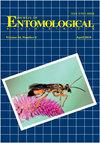Laboratory-Based Mate Choices of Two Eccritotarsus Species (Hemiptera: Miridae) Used as Biological Control Agents of Water Hyacinth, Pontederia (Eichhornia) crassipes (Pontederiaceae), in South Africa
IF 0.7
4区 农林科学
Q4 ENTOMOLOGY
引用次数: 1
Abstract
Abstract Many biological control agents have been released to manage the water hyacinth, Pontederia (Eichhornia) crassipes (C. Martius) Solms-Laubach (Pontederiaceae). They include two Eccritotarsus sources from Brazil and Peru. Distinguishing features between the two were found, necessitating their redescription. The Brazil source remained Eccritotarsus catarinensis (Carvalho), whereas the Peru source is Eccritotarsus eichhorniae Henry. Our objectives in this laboratory study were to assess the mate choice in the two species and, thus, determine which species performs better than the other. Mate choice in the form of no-choice, bichoice, and multichoice tests were conducted within and between species in a 3:1, 2:1, and 1:1 sex ratios. The E. catarinensis pair had short copula latency but long copula duration in multichoice experiments, whereas the E. eichhorniae pair had short copula latency but long copula duration in no-choice experiments. In no-choice and bichoice experiments, E. eichhorniae♀ and E. eichhorniae♂ outcompeted E. catarinensis♀ and E. catarinensis♂. In multichoice experiments, E. catarinensis♂ outcompeted E. eichhorniae♂, whereas E. eichhorniae♀ outcompeted E. catarinensis♀. Despite being shown to be more fecund, E. eichhorniae is likely not to outcompete E. catarinensis where the two species co-occur and that E. catarinensis♂ and E. eichhorniae♀ will outcompete their counterparts. Previous research indicated that when E. catarinensis♂ and E. eichhorniae♀ are crossed, they produce few offspring, underscoring the need to confirm if the two species will coexist, compete, or displace each other in their natural habitats. Our findings further support that prezygotic reproductive isolation mechanisms led to the speciation of these species.南非水葫芦、蓬属(Pontederia, Eichhornia)、十字花科(pontederipes)生物防治剂两种蜱虫的实验研究
摘要:水葫芦(Pontederia), Pontederia (Eichhornia), crassipes (C. Martius), Solms-Laubach (Pontederiaceae)的生物防治已被广泛应用。它们包括来自巴西和秘鲁的两个Eccritotarsus来源。发现了两者之间的区别特征,有必要对它们进行重新描述。巴西源为卡塔林星(Carvalho),秘鲁源为亨利星(eccriitotarsus eichhorniae Henry)。我们在这个实验室研究的目的是评估两个物种的配偶选择,从而确定哪个物种比另一个物种表现得更好。在物种内部和物种之间以3:1、2:1和1:1的性别比例进行了无选择、双选择和多选择的配偶选择测试。在多选择实验中,卡塔林夜蛾对交配潜伏期短,交配持续时间长,而在无选择实验中,双角夜蛾对交配潜伏期短,交配持续时间长。在无选择和双选择实验中,eichhorniae♀和eichhorniae♂优于eichhorniae♀和ecatarinensis♂。在多选择实验中,catarinensis♂优于E. eichhorniae♂,E. eichhorniae♀优于E. catarinensis♀。尽管被证明更多产,E. eichhorniae可能不会胜过E. catarinensis在两个物种共存的地方,E. catarinensis♂和E. eichhorniae♀将胜过它们的对手。先前的研究表明,当e.c arcatarinensis♂和e.e eichhorniae♀杂交时,它们产生的后代很少,这强调了确认这两个物种是否会在自然栖息地共存、竞争或相互取代的必要性。我们的发现进一步支持了前合子生殖隔离机制导致这些物种的形成。
本文章由计算机程序翻译,如有差异,请以英文原文为准。
求助全文
约1分钟内获得全文
求助全文
来源期刊
CiteScore
1.20
自引率
11.10%
发文量
40
审稿时长
>12 weeks
期刊介绍:
The Journal of Entomological Science (ISSN 0749-8004) is a peer-reviewed, scholarly journal that is published quarterly (January, April, July, and October) under the auspices of the Georgia Entomological Society in concert with Allen Press (Lawrence, Kansas). Manuscripts deemed acceptable for publication in the Journal report original research with insects and related arthropods or literature reviews offering foundations to innovative directions in entomological research

 求助内容:
求助内容: 应助结果提醒方式:
应助结果提醒方式:


